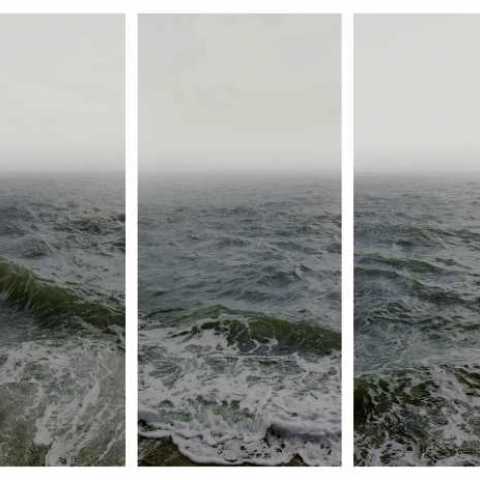Flowers Kingsland Road
82 Kingsland Rd
London
E2 8DP
United Kingdom

British photographer Nadav Kander is best known for Yangtze - The Long River, for which he earned the prestigious Prix Pictet award in 2009. His ongoing series, Dark Line - The Thames Estuary, is a personal reflection on the landscape of the River Thames at its point of connection with the sea, through atmospheric images of its slow-moving dark waters and seemingly infinite horizons. Kander's increasingly abstracted photographs describe the landscape through minimal compositions and a painterly layering of tones that appear to stain or bleed through the photographic surface, conveying an inner experience parallel to that of the visible world.
The landscape of the Thames Estuary, studded with marshes and quicksand, resists settlement and remains hostile to the wary visitor. Drawn to a sense of concealment within this environment, Kander's photographs are shaped by the psychogeography of the estuary, echoing the shrouded histories embedded in the silt of the river. Images of heavy skies and dark, turbulent waters summon memories of the toil and grit of the many thousands who have worked the river since Roman times, and recall the grimness of its history - of pirates roaming the waters, and ships sunk in battle.
Once known as the busiest trading route in the world, the estuary waters of the River Thames open out towards the great Continental trading rivers of Europe, and the world beyond. Although many of these images were photographed long before the ideas of separation from Europe became reality, the brooding sense of isolation now suggests borders and boundaries rather than points of connection. Bleeding into darkness, Kander's images of the river's continual flow harbour a lingering sense of loss and longing, of uncertain futures.
Making repeated journeys along the banks of the estuary over a period of more than two years, Kander determined his starting points from historic sites or points of interest, such as disused artillery forts and quarries. From these locations, he followed an intuitive path, often guided by evidence of an abiding human imprint. From the mysteriously-named and sparsely-populated shores of the Hoo Peninsula, the distant horizon is broken by the dramatic, cathedral-like presence of Kings North Power Station and the giant cranes emerging from the mist across from Grain Marshes. Smaller figurative elements such as abandoned structures and boats falling into ruins on the river banks hint at a pervading sense of desolation on a human scale.
Kander attributes much of the philosophy behind his practice to his interest in Chinese Shan Shui scroll paintings (literally translated as mountain and water), which conjure the mystical drama of the natural world, balancing the minutiae of daily life against the infinity of the cosmos. The scroll-like vertical format of works in the series reflects the proportions of the human body, demanding that the works be experienced physically. Presented low to the ground, they evoke a sense of weightlessness, inviting the viewer to 'step off' into the image. Several works are presented as diptychs or triptychs, implying the passage of time and timelessness, echoing the river's perpetual cycle of change and renewal.
In the production of Dark Line, Kander's slower method of working has mirrored the pace of the river, developing a reductive abstract language to replace the ultra-realism of photography. Kander says: 'Today's popular imagery is in some ways replacing language. People speak of their 'snapchat story' and emojis replace longer writing forms describing emotion. I wish to make work that does not literally describe what is in front of me. I do not wish to focus my lens and capture a millisecond of realistic information. I am moving away from common perceptions that photographs are the result of a lens that 'focuses sharply' on what is in front of it.â€
On display for the first time, the exhibition will also include a specially created video installation by Nadav Kander.
